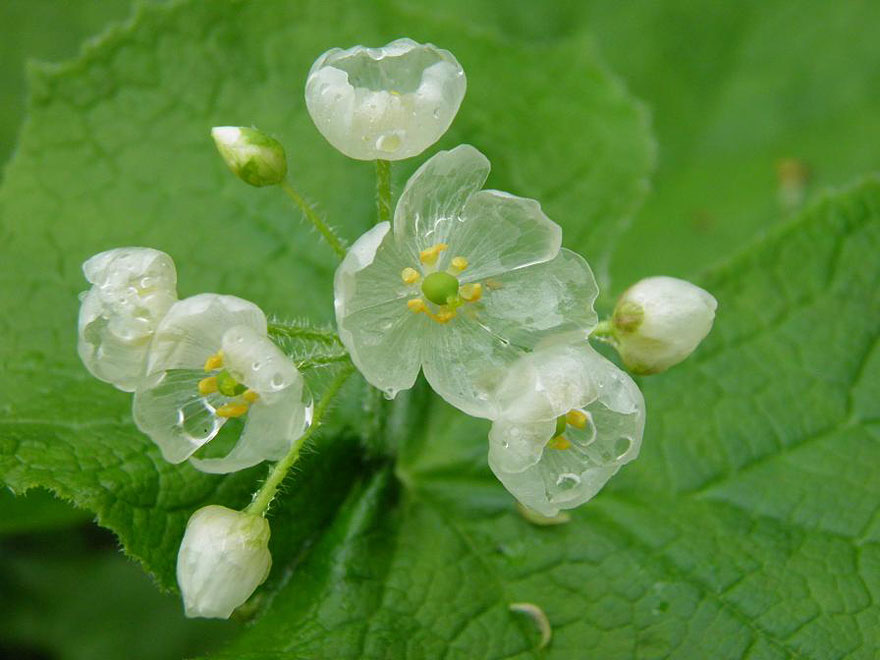
Skeleton Flower: A Complete Guide on How to Grow and Care for It
Say hello to the enchanting skeleton flower, transparent botanical wonder, also known by its scientific name Diphylleia grayi. This delicate, mystical, white woodland bloom, aptly named for its striking resemblance to the skeleton, has captivated the hearts of plant enthusiasts and nature lovers alike.
Diphylleia grayi is also called an umbrella plant or Asian umbrella leaf because of its native habitat and growing green foliage with clusters of tiny white flowers. The skeleton flower, a member of the Berberidaceae plant family, is known for its ethereal, bone-white petals.
Nature has manymiracles, such as air plants, which you can grow without soil, or moon flowers — night-blooming plants that open their large, fragrant blossoms in the evening and close them in the morning. If you are interested in why the skeleton flower is so special, we’ll lead you through it! Our guide will explore the art of cultivating and caring for the skeleton flower, uncovering its distinctive characteristics, and answering the most popular questions.
Whether you’re an experienced gardener looking for a unique quality botanical repertoire or a newcomer to the world of horticulture, this guide will provide you with the knowledge and inspiration to appreciate the uniqueness of the Diphylleia grayi. Join us on this journey as we unveil the secrets of the skeleton flower, a true wonder in the world of flora.
Why Is it Called a Skeleton Flower?
Skeleton flower earns its intriguing name due to its remarkable reaction to water, mainly rain. So, why do skeleton flowers turn transparent? A transformation occurs when raindrops touch this unique bloom’s delicate, bone-white petals. So, what exactly happens when it rains on a skeleton flower?
The petals, which initially appear solid and opaque, gradually become translucent, revealing the intricate network of veins resembling a skeleton’s structure, hence the name. It happens because the fragile petals lose their pigment when wet. As the flowers dry up, they turn white again. This flower, transparent like delicate lace veils, unveils its inner beauty with grace and mystery.
The remarkable phenomenon of the flower’s cells filling with water has captured the imagination of nature enthusiasts and curious minds alike. It’s a captivating demonstration of nature’s artistry and one of the many reasons this transparent flower is highly regarded in botany. When it rains on a skeleton flower, it unveils its inner beauty, offering a magical spectacle that never fails to leave a lasting impression.
Where Do Skeleton Flowers Grow?
Skeleton flowers grow in the mountain regions of China and Japan or the Appalachian mountains in the USA, where they prefer shady and moist conditions under the canopy of deciduous trees. They are hardy in USDA zones 4 to 9, but you can quickly acclimate the plants to colder regions. They aren’t suitable for indoors or container gardening, as they need a dormancy period in winter and well-drained mulch rich in organic matter.
Is the Skeleton Flower a Perennial or Annual Plant?
Annual plants have a life cycle of one growing season and then die. Annual typically refers to plants whose dormant seed is the only part that survives one growing season and dies back in winter. However, what about perennial plants? What is a perennial plant?
Perennial plants live for more than two years, differentiating them from shorter-lived annuals and biennials. Perennials can be woody or herbaceous and have the ability to produce flowers and fruits over many seasons. Some examples of woodland perennials are wood anemone, primrose, red campion, foxglove, erythronium, and skeleton flower.
A skeleton flower is a deciduous perennial plant that blooms from May to July develops clusters of bright blue berries in early autumn, and then dies back in winter.
Are Skeleton Flowers Hard to Grow?
This transparent flower isn’t hard to grow, although there are some requirements you have to take into consideration. It’s a slow-growing perennial that can live for many years if given the right conditions. You can grow skeleton plants in soil with a pH between 4.5 and 7.012. Make sure the soil is rich in organic material, including plenty of compost, peat moss, dead foliage, and humus.
Prepare the soil by covering it with a layer of mulch. This helps retain moisture, prevent weeds, and improve soil structure, water retention, and plant nutrient availability. Skeleton flower grows best in well-drained soil rich in organic matter. If the soil is too wet, the roots may rot, and the plant may die, so the plant needs good drainage.
Growing this transparent flower from seed or seedling is possible, but it isn’t easy. The seeds are rare and hard to find, requiring special germination conditions. According to Raya Garden,skeleton flower seeds need a cool weather cycle and can take up to a year or longer to sprout. The best way to propagate it is by dividing their rhizomes and replanting them in moist, shady soil. They can be divided every few years in early spring.
How to Care for a Skeleton Flower?
The skeleton flower doesn’t require much maintenance, grows naturally in the woods, and is generally resistant to pests or diseases. This transparent flower is very sensitive to sunlight, so it’s best to plant it in shady locations, as it requires partial to complete shade. However, there are a few more skeleton flower care tips. Here are some of them:
- Increase the watering of the skeleton flower plant when the top layer of soil feels dry.
- During a dry period, ensure a constant supply of water. You should water it slowly and deeply by drip irrigation.
- Add a thin layer of mulch around the base of the plant to help maintain consistent moisture levels.
- Apply a complete fertilizer in the early spring if there isn’t natural organic matter from fallen leaves.
- The plant dies back during the winter. If you live in Zones 4 to 9, the plant can survive freezing temperatures with a light layer of mulch.
Good Luck Growing Skeleton Flower in Your Garden!
With enchanting translucent petals that transform before your eyes, the skeleton flower is a captivating addition to any garden. We hope that this guide has equipped you with the knowledge and tips to successfully cultivate and care for this mountainous plant. So, don’t miss the opportunity to introduce the Diphylleia grayi into your garden and watch it weave its mesmerizing spell on your outdoor space!
144Kviews
Share on Facebookin all fairness, they probably should have said in North America then :)
in all fairness, they probably should have said in North America then :)

 Dark Mode
Dark Mode 

 No fees, cancel anytime
No fees, cancel anytime 





















































145
20